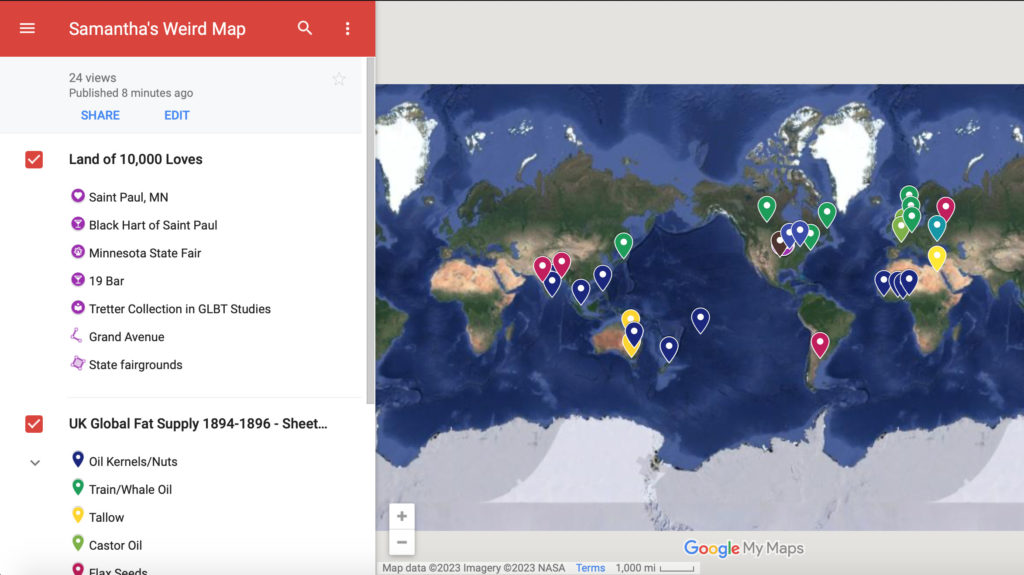Skill #1
Hi. I’m Samantha Rosenthal (she/they). This is my sandbox for HIST 209: Introduction to Digital History. I am Associate Professor of History and coordinator of the Public History concentration at Roanoke College as well as co-founder of the Southwest Virginia LGBTQ+ History Project. I am the author, most recently, of Living Queer History: Remembrance and Belonging in a Southern City. I guess I’m your typical trans girl because, despite being a historian and a humanist, I’m also a bit of a digital nerd. Downright cyborgian.
Skill #2

Skill #3
Using OCR to research women’s history

The article “Victoria Woodhull Again” seems to be some kind of syndicated story that was perhaps simultaneously published in many newspapers; there is no evidence that this was written locally by a Roanoke journalist, or that the story pertains to any local or regional matters. It reminds me of a kind of tabloid journalism, keeping tabs on the whereabouts of a once-scandalous woman. The inclusion of an image plays into that ‘tabloid’ feel. I’d like to know more about the Southern press’s take on her ‘free love’ ideology, but this article doesn’t really tell us that. It does, however, show us the benefits of optical character recognition (OCR) software for conducting research with digitized 19th-century newspapers.
Using machine-reading to compare presidential inaugural addresses, Carter (1977) vs. Reagan (1981)


I was curious to see how Carter and Reagan may have each responded to the cultural revolutions of the 1970s, including Black Power, women’s liberation, gay liberation, the American Indian Movement, the disability movement, and anti-war and anti-government sentiment. I am struck by the word “new” in Carter’s address. He really wanted to turn the page on the Nixon-Ford administrations and their darker view of America. The prevalence of “people,” too, along with “together” and “freedom,” perhaps is Carter’s attempt to speak to the diverse, and angry, constituencies of 1970s America? Reagan, on the other hand, whose election represented the ascendance of the modern conservative movement propelled by a politicized evangelical movement, more often used words like “American” and “government” to describe his approach. It’s “government” rather than “people” for Reagan, “will” versus “can,” and interestingly, Reagan’s “man” versus Carter’s “human.”
Anyway, these word clouds evidence the use of distant reading as a methodology that looks for broad-based patterns within a corpus of text. Humans can do this task, but it would take us many hours to tally the frequency of every word and then figure out which words were used the most. This is also an interesting example of using computers to analyze small data (only a few thousand words) rather than the big data we so often hear about.
Using machine-reading to research transgender history

I wanted to see how interest in four iconic twentieth-century American trans women changed over time as represented in an English-language corpus of books. Christine Jorgensen had her peak moment of fame in the 1950s. Renee Richards became the center of public controversy in the late 1970s. Sylvia Rivera and Marsha P. Johnson are remembered today most significantly for their activism in New York City in the early 1970s, but they were completely unknown to mainstream book-reading audiences until, really, the twenty-first century. I interpret the twenty-first-century data to speak to the changing foci of transgender historiography over the past few decades. Interest in Rivera and Johnson as trans women activists of color continues to increase while Richards is increasingly forgotten (but maybe recent transgender sports bans will resurrect her?) and Jorgensen’s star has fallen a bit, too.
The Google Ngram evidences distant reading as a methodology for working with big data (in this case, millions of English-language books published between 1950 and 2019).
Skill #4

A spatial representation of, for some reason, both a personal queer history of St. Paul, Minnesota and the history of British global fat imports in the 1890s. What could these two things possibly have to do with one another? Although lard extracted from animals in the famous stockyards and meatpacking district of Chicago in the 1890s was part of a global capitalist economy, maybe this explains immigrant histories in the upper Midwest—including in the flour-milling metropolis of Minneapolis—that led to the emergence of the Twin Cities’ heterogenous transgender community in the early twenty-first century. I just don’t know. But now I’m curious.
Skill #5
Skill #6
Skill #7

Check out my Twine, a text-based video game. To play, click on this link. The link will pull up an HTML file. Click “Download.” Now, open the website for Twine, click “Use in your Browser.” Click “Library,” then “Import,” and choose the HTML file you just downloaded. Click on the imported story, “Samantha Goes to St. Paul.” Now click “Build,” then “Play.” Voila: it’s my game!
